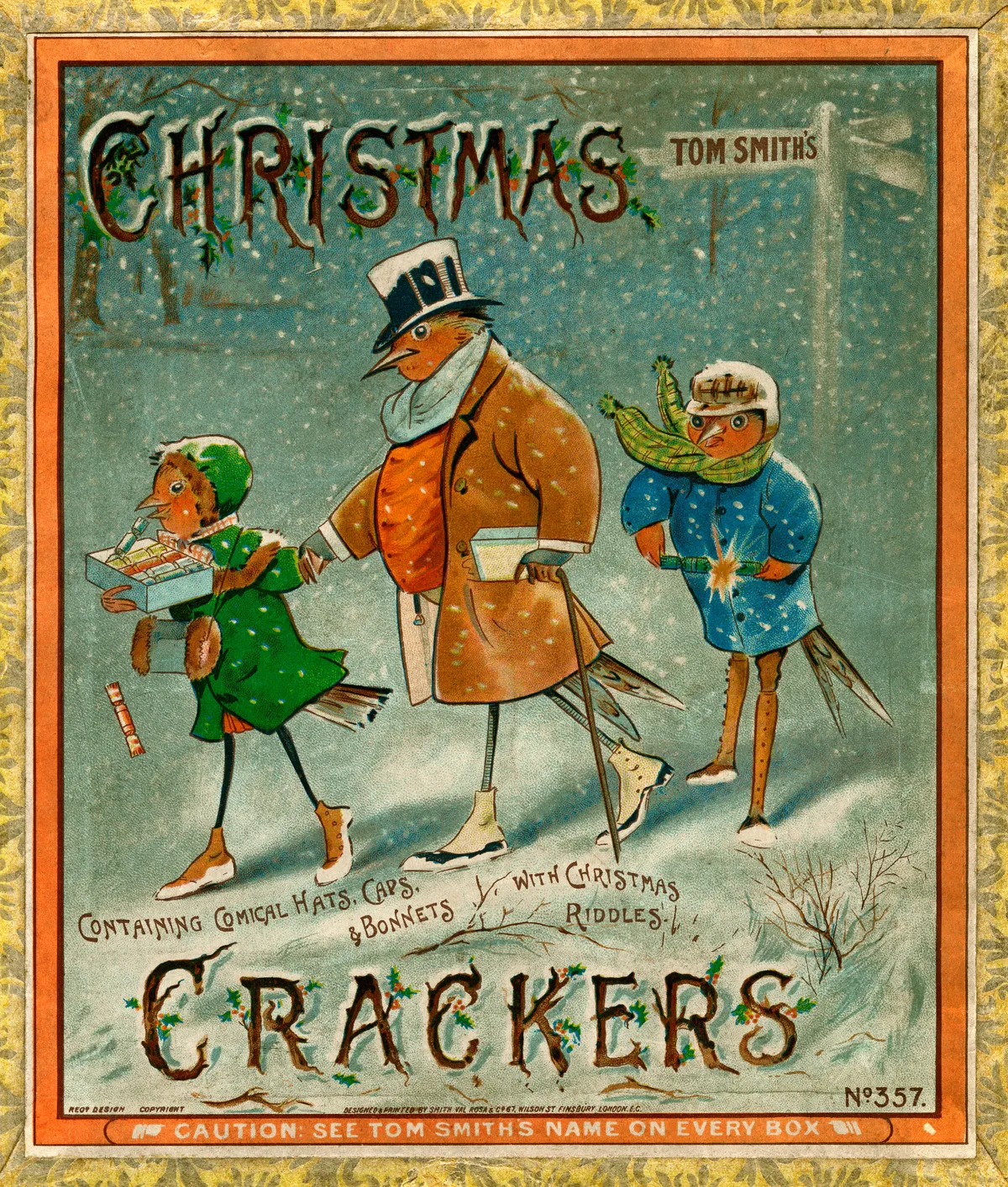London confectioner Tom Smith (1823-1869) invented Christmas crackers in 1847 following a trip to Paris, where he discovered the French custom of giving children bonbons – sugared almonds wrapped in twisted paper that contained a romantic sentiment or message. Spotting the potential of bonbons for his own sweet shop, he decided to bring the idea back with him to his business in Goswell Road, Clerkenwell. By 1849 the bonbon had been replaced by toys and trinkets contained in a larger wrapper.
In the 1850s, Smith decided that his idea needed a little boost. Legend has it that one evening he threw a log onto his fire and was inspired by the ‘cracking’ sound it made. Following this eureka moment, and after a period of experimentation, the ‘snap’ element was added to his product in 1860, which he decided to name ‘Bangs of Expectation’. The product then came to be called ‘cosaques’ (after the sound of the Cossack whip), with ‘cracker’ quickly coming into popular usage because of its resemblance to the sound that was generated.
By 1889, Tom Smith’s (then managed by his sons) employed 2,000 workers, working year-round to produce 112,000 boxes of Christmas crackers every year. Modifications to the original concept were made over the years – notably the inclusion of the paper crown, attributed to Henry Smith, one of Tom Smith’s sons, which an Illustrated London News reporter described in 1894 as “simply Parisian in its elegance”. The same journalist was in similar raptures over the motto: “You ask me why I love you; I can give no reason why. I only know I love you, And shall do till I die. What simplicity! What directness! How refreshing amidst the morbid imaginings of a decadent age.” Mottos such as these were gradually replaced by notoriously bad jokes, prompting the Westminster Gazette in 1906 to describe a particularly badly written play as being “not up to the standard of cracker poetry”.

Most Christmas crackers today are mass-produced in China, but in the 19th century they were made by basic cutting and rolling machines, and by hand. The workforce primarily consisted of women and children. Printed sheets would be ‘pinned up’ so that up to 1,000 sheets of cracker paper could be guillotined together before being sorted into themes according to what was to go into them. Ornamental edges would be cut via a steel cutter and fringes by “roller knives, the edges of the paper being permitted to pass between steel rollers to the extent of an inch or so and then withdrawn” (the Pall Mall Gazette, December 1889). A wooden roller would be used to form the tube of the Christmas cracker, before a piece of string or ribbon would be “drawn over the wrapper and drawn between the ends of the rollers outside the embryo cracker, and the division or crease is thus formed”. The gifts and cracking strip were placed inside by hand, before the other end was tied. The cracking strip was formed by mixing fulminate of silver with sand on two pieces of narrow card, so that “when each end is pulled in an opposite direction… the sand and silver frictionise [sic]”. Silver fulminate had been available since the beginning of the 19th century, but Smith’s use of it was allegedly the first of its kind.
Smith didn’t initially intend his invention to be used at Christmas. In fact, in the late 19th and early 20th century manufacturers produced crackers in line with news trends and current affairs. As a result suffragism, Charlie Chaplin and even the Anglo-Egyptian War of 1882 have all appeared on crackers. According to an article in the Stamford Mercury in December 1898, cracker catalogues were produced showing a “bewildering variety… hence we have the Spanish-American war crackers. The figures of Jonathan and the Matador are on the box, the Spanish colours and the Stars and Stripes being in evidence, whilst Cuban and Spanish head-dresses and pictures fill up the interior of the cracker.”
Christmas crackers also helped with the war effort. In the First World War patriotic designs featuring an English soldier with a German eagle on a lead boosted morale, while during the Second World War the Government used cracker strips in soldiers’ training to imitate gunfire. Coupled with paper rationing, this brought Christmas cracker production to a halt.

It should also be noted that Tom Smith wasn’t the only confectioner who claimed to have had the idea for the Christmas cracker. At around the time of his fateful visit to Paris, the Italian-born Gaudente Sparagnapane (another Londoner, not to mention the father of actor and suffragette Maud Sennett) was establishing himself as not only an “oriental confectioner” but also “the oldest maker of Christmas crackers in the United Kingdom”. He established his company in 1846, a year before Smith, giving him the best rival claim to the (paper) cracker crown, but his legacy has been all but lost to history.
Another claim to Christmas cracker fame came from James Hovell, who was also running a confectioner’s in the mid-19th century and began to produce crackers in the same style as Smith and Sparagnapane.
Peter Kimpton, the world’s only Christmas cracker historian, pragmatically writes, “Perhaps Tom Smith was simply an excellent marketing man and did a good job in getting the message out that the idea was his.”